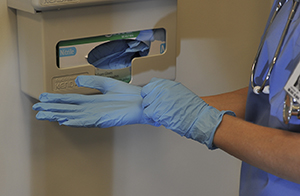Understanding Latex Allergies
An allergy is a sensitivity to a certain substance. If you have a latex allergy, you’re sensitive to natural rubber latex. This is a growing problem among people who work in healthcare. This sheet tells you more about the causes and symptoms of latex allergy.
 |
| Using nitrile gloves can reduce your exposure to latex. |
What is latex?
Natural rubber latex is made from a liquid taken from the rubber tree. Common products that often contain latex include:
-
Surgical gloves
-
Balloons
-
Condoms
-
Urinary catheters
-
Resuscitation equipment
-
Diaphragms
-
Rubber bands
-
Rubber balls
-
Baby bottle nipples
How latex allergy develops
Latex protein is the allergen that causes latex allergy. The more a person is exposed to latex protein, the more likely they will develop latex allergy.
If the latex gloves are also powdered, the powder can carry particles of latex into the lungs. This can cause respiratory symptoms.
Know the symptoms of latex allergy
-
If latex touches your skin, you may have a local reaction. For instance, you may have a rash, hives, or blisters on your skin.
-
If latex gets into your lungs or bloodstream, you may have a systemic reaction. This means you may have symptoms that affect your whole body. For instance, you may have itchy, red, watery eyes and sneezing. You may also have coughing, trouble breathing, and chest tightness .
-
In either case, symptoms can occur right away or they can occur many hours later. Also, symptoms can range from mild to severe.
Know the signs of anaphylaxis
In rare cases, latex allergy can cause anaphylaxis , a medical emergency. It must be treated right away because it can be fatal. Signs of anaphylaxis include:
-
Severe hives and itchy skin
-
Swelling of the throat and or tongue
-
Wheezing, trouble breathing
-
Chest tightness
-
Facial flushing
-
Rapid, pounding heartbeat
-
Feeling faint; loss of consciousness
If you have serious allergies, including a serious latex allergy, be sure to wear medical alert identification. In addition, your healthcare provider may prescribe an epinephrine auto-injector. Use it if you have one. Also call 911 or go to the emergency room (ER).